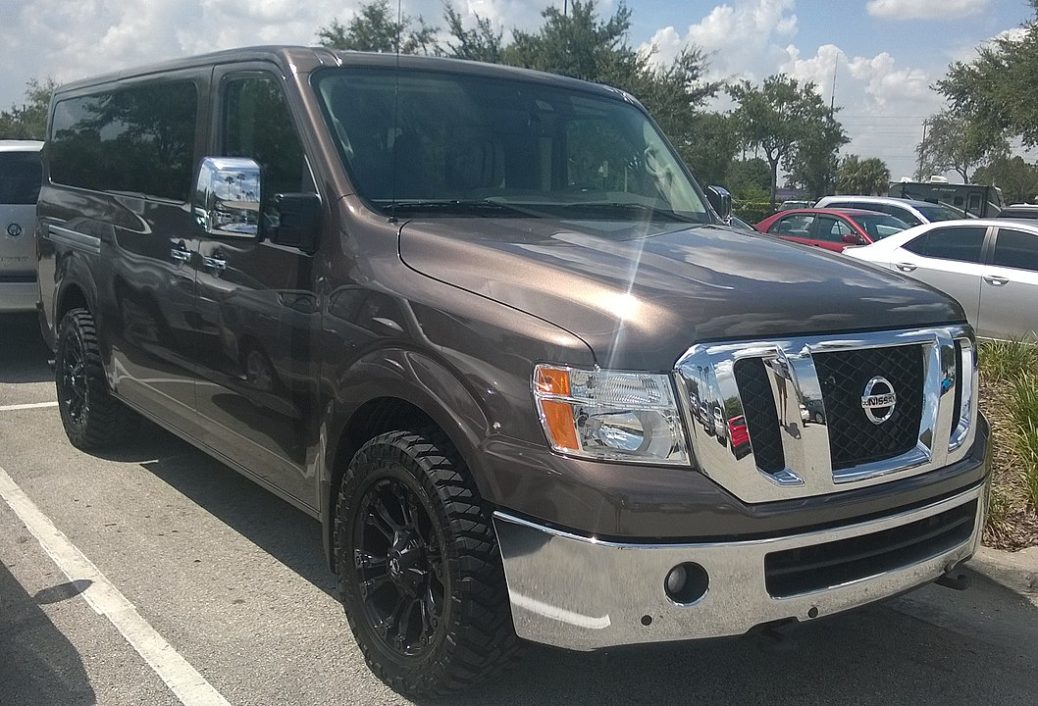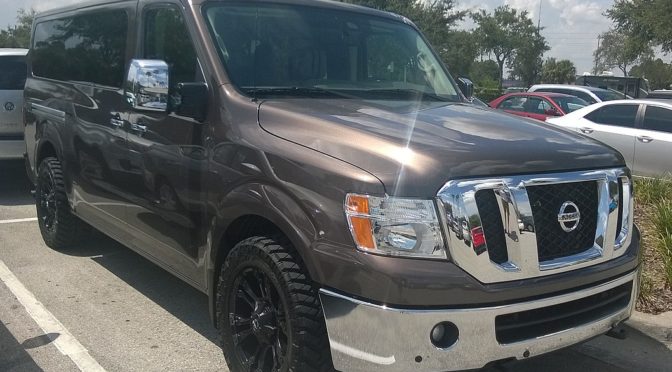
There are a few themes I drive home in nearly every post on the CCD. One involves the need to use best practices the moment you become aware of them, rather than wait for institutions like governments or corporations to acknowledge them. Another has to do with an understanding of what happens when best practices are followed vs what happens when they aren’t due to a lack of knowledge or discipline. A third is perhaps even more fundamental: the need to identify what best practices are, followed by the decision to follow them. This might be the most challenging, as it involves the most detective work as well as the most discipline. However, without it, the other processes don’t matter; you can’t discuss crash scenarios when you have no idea why they occurred or what could have been done differently, and you can’t advocate for best practices if you don’t know what they are.
This brings us to today’s topic: the Nissan NV Passenger Van, or NV3500. It’s one of the most popular choices today in the United States among large families, religious groups, and school and para school functions, along with competing vans like the GMC Savana, Ram ProMaster City, and Ford Transit. However, this is where the cracks start forming in the ice. First, full-sized vans have a spotty safety record. In a country that’s no stranger to avoiding safety mandates, we literally have laws against where such vans can be used as legitimate forms of transportation. Full-sized vans can’t be sold or leased as new vehicles to schools because of how unsafe they’re considered to be compared to school buses unless they include a number of additional features and safety standards under FMVSS regulations that apply to school buses and Multifunction school activity buses, or MFSABs (full-sized or short buses not used for transport during school hours). With that noted, full-sized vans are also less likely to be thoroughly crash tested by our two primary crash testing organizations in the United States, the NHTSA, or National Highway Transportation Safety Administration, and the IIHS, or Insurance Institute for Highway Safety. We can somewhat excuse the IIHS since they’re a private organization, although that does again illustrate the drawbacks of placing public safety issues in the hands of private corporations, but there is no excuse whatsoever for the NHTSA to refrain from testing any full-sized van to the same degree as any other non-bus-sized vehicle intended for public transportation. But that’s where we are right now.
Which crash tests has the NHTSA and IIHS conducted on the NV3500?
As of this writing (February 2020), the NHTSA has never performed a crash test on the Nissan NV Passenger Van, the NV3500. The IIHS has never crash tested the NV3500. In other words, there are no publically available standardized crash tests in the United States for this vehicle that are comparable to crash tests for any other vehicle in the country. To go a step further, the IIHS has never published a standardized crash test for any full-sized van made in the 21st century.
What does this mean?
It means that if you buy an NV3500, you literally have no idea how it will perform in a crash. Yes, it includes ESC, which is great; that’s the biggest development in car safety since frontal and side airbags and the lap and shoulder seat belt. Yes, it includes side curtain airbags. Yes, Nissan says it’s safe. But have you ever heard a car manufacturer say otherwise before public or governmental pressure forced it to? No. The truth is that we don’t know what the NV3500 would do in a full frontal crash, in a moderate overlap crash, in a small overlap crash on the driver’s side, in a small overlap crash on the passenger’s side, or in a side pole crash. We also don’t know how many times its weight it can support, because it’s never been roof crush tested. These are all tests the NHTSA and IIHS peform on nearly every passenger vehicle sold today in the United States. But these test results don’t exist for the NV3500, a van designed to carry 12 people at highway speeds on public roads. It could be a death trap for all we know, because we simply don’t know.
Why is it important to have this information, and how could we get it?
When I write about side impact crush resistance and how the Honda Odyssey is the safest minivan in the country due to a B-pillar crush resistance of 21.5 cm as measured in the IIHS side impact test, that tells you something. You have an idea of exactly where that minivan and that rating stand in comparison to every other minivan sold, as well as every other car or SUV or pickup truck you’re likely to consider. But that number–as well as just about every other safety-based number–is missing when it comes to the NV3500. How much would that B-pillar hold? I have no idea, and you don’t either, because it’s not publically available information.
Could we find out?
Sure, with around $40,000, which is what it would cost to buy an NV3500 and contract a private agency to test it (or buy the equipment to do so yourself). But much like paying for your own heart surgery out of pocket (or sending your spouse to medical school in order to get the job done in-house), that’s beyond the reach of most individuals, which is precisely why we pool risk and huge expenses through governmental programs. In this case, the relevant governmental program would be the NHTSA. In the private sector, it would be the IIHS. However, neither has stepped up to the plate, and since the IIHS is a private institution, it has no legal obligation to do so. Technically, neither does the NHTSA, but it does have a functional and moral obligation to do so, as it is funded entirely by public dollars to serve the public good. And it is negligent to eschew crash testing of vehicles used by private individuals and sold in significant numbers simply due to bureaucracy.
Is there a way to convince the NHTSA to test the NV3500?
Certainly! You can write letters and emails, but this is unlikely to get results, as big organizations don’t listen to little people unless we speak in large enough numbers; Dr. Seuss famously noted as much in Horton Hears a Who! The practical way of getting this done will be if someone famous enough dies in an NV, much as how the FAA is highly likely to mandate TAWS in helicopters after the Calabasas crash involving Kobe Bryant and 8 other victims, despite ignoring NHTSA recommendations for more than 10 years and counting. The problem here is that it might take a lot of little people dying (and most likely will) before a big person does, especially since the big people are more likely to use giant coach buses. Alternatively, if a large number of little people die at once, such as in a crash involving many dead schoolchildren, the public outcry again would likely drive the NHTSA to action. However, since the NHTSA already banned the new sale of such vans for school purposes unless they included school bus-type enhancements, such deaths are unlikely to occur.
In other words, we’re probably going to continue waiting for a while for these results, barring a surprisingly large number of newsworthy deaths involving NV3500s. Which is awful. But that’s how our government tends to work when it comes to road safety.
Does this mean we don’t buy the NV3500 until it’s crash tested?
In my opinion, yes. Don’t reinforce the government’s irresponsibility by purchasing vehicles it refuses to crash test. It’s not your job to be the dummy; there are perfectly good ones out there used each day in crash testing facilities.
It’s also worth keeping in mind that, as noted earlier, no full-sized van currently sold has ever been tested by the IIHS, although the Ford Transit has been tested by the NHTSA in frontal, side, and pole collisions (and has done well). You simply aren’t going to get a complete picture of full-size van safety relative to minivan, car, pickup, or SUV safety right now in the United States.
That said, if you already have an NV3500, this doesn’t mean you have to sell it. As I’ve always noted and continue to do on the CCD, the lion’s share of difference in whether you make it home to your loved ones each night or not isn’t what you drive, but how and where you drive. Focus on those elements and you’ll be safer in an NV than just about anyone you see driving just about anything else on the road.
 If you find my information on best practices in car and car seat safety helpful, you can buy my books here or do your shopping through this Amazon link. Canadians can shop here for Canadian purchases. It costs nothing extra to do so, but when you shop through my links, a small portion of your purchase, regardless of what you buy, will go toward the maintenance of The Car Crash Detective.
If you find my information on best practices in car and car seat safety helpful, you can buy my books here or do your shopping through this Amazon link. Canadians can shop here for Canadian purchases. It costs nothing extra to do so, but when you shop through my links, a small portion of your purchase, regardless of what you buy, will go toward the maintenance of The Car Crash Detective.

